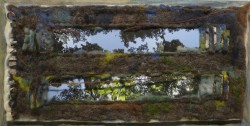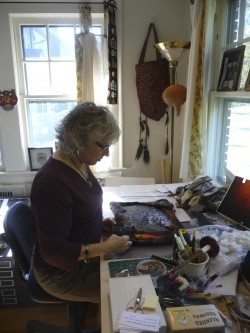A Few Words About Feltmaking
 Feltmaking is one of the oldest techniques for creating fabric, probably beginning about 8000 years ago. It is the speeding up of a natural process whereby the wool fibers mat together when subjected to heat, moisture, and pressure or agitation. Wool fibers are made up of scales that open and close, entangle and shrink, and lock together to form a dense fabric. Early humans may have noticed matted wool on sheep, or may have stuffed bits of wool inside foot coverings. After days of walking the wool would have matted into a solid piece of fabric. Unlike woven textiles, handmade felt requires very little equipment, and can be produced more quickly. Nomadic peoples traveling with their sheep used this process for creating homes (yurts), rugs, blankets, cloaks, hats, shoes, and bags.
Feltmaking is one of the oldest techniques for creating fabric, probably beginning about 8000 years ago. It is the speeding up of a natural process whereby the wool fibers mat together when subjected to heat, moisture, and pressure or agitation. Wool fibers are made up of scales that open and close, entangle and shrink, and lock together to form a dense fabric. Early humans may have noticed matted wool on sheep, or may have stuffed bits of wool inside foot coverings. After days of walking the wool would have matted into a solid piece of fabric. Unlike woven textiles, handmade felt requires very little equipment, and can be produced more quickly. Nomadic peoples traveling with their sheep used this process for creating homes (yurts), rugs, blankets, cloaks, hats, shoes, and bags.
 To make felt, the wool must be carded and stacked in layers. The direction of the fibers alternates 90 degrees in each layer. The number of layers and the length of time felting determines the thickness and density of the felt. You can see in my work the different layers that are revealed as I cut into the felt and peel back the layers. I have carefully composed the layers, particularly the top surface, though it was my intention to make the felt look very natural. The stacked layers are wrapped in a piece of sheet material or netting, wet with hot water, and a bit of liquid soap. Then the hard work begins. Each of my pieces seen here took about an hour of rolling and pressing, flipping to the other side, rolling, pressing, unrolling, again until a solid piece is created. The process is very physical, and magical at the same time.
To make felt, the wool must be carded and stacked in layers. The direction of the fibers alternates 90 degrees in each layer. The number of layers and the length of time felting determines the thickness and density of the felt. You can see in my work the different layers that are revealed as I cut into the felt and peel back the layers. I have carefully composed the layers, particularly the top surface, though it was my intention to make the felt look very natural. The stacked layers are wrapped in a piece of sheet material or netting, wet with hot water, and a bit of liquid soap. Then the hard work begins. Each of my pieces seen here took about an hour of rolling and pressing, flipping to the other side, rolling, pressing, unrolling, again until a solid piece is created. The process is very physical, and magical at the same time.
I learned to make felt during my years in the fiber department at Philadelphia College of Art and have been fascinated with it ever since. Several years ago I was traveling in Western China and finally had the opportunity to visit a yurt. My guide asked a group of Kazakh women if anyone had a felt rug they would be willing to sell. One woman took me into her yurt and laid out all of her rugs. Many were very large, and I chose one that I could carry back to the United States. It now sits on the floor of my studio and allows me to feel a connection to other cultures and times.
–Ellen Weisbord
GARDEN PATH SERIES
Felt & Photography 2008-2009
In the summer of 2002 I created a stone path in my back yard in South Orange, NJ, and have since observed the naturalization process. Over the years, I have walked the path as part of my outdoor yoga practice. In this Garden Path Series, I have merged my interests in feltmaking, photography, gardening, and yoga and a deep connection to the world around me. This daily walking meditation allowed me to observe and document changes from the minute to the extreme. The Meditation pieces include images of the stones as I walked them, the Reflection pieces show the path under water after many days of rain, and the Salutation pieces are views looking up from the path. I often felt as though I were moving around a game board representing life’s journey, and have chosen images of playing pieces to serve as human surrogates.
The creation of the pieces of wool felt, a very physical process, was similar to the physical effort required in the making of the stone path. It was my intent to create felt that looked very earthy. Cutting into the layers of the felt and peeling it back to insert the photographs, reflected the act of cutting into the ground and removing layers of sod in order to set the stones for the path. I sought, however, to give the sense of opening a way into some other dimension or internal space.
It is my hope that this visual expression of a reality that I experienced both externally and internally, will invite viewers to respond with journeys of their own interpretation.
SEA ANEMONE AGGREGATION
Coiled Baskets 2010-2011
On two visits to the coast of northern California, I was captivated by the rich diverse life of tide pools, especially aggregations of sea anemones. This group of coiled baskets captures the changing nature of sea anemones that close to protect themselves from drying out at low tide, and open their tentacles when under water at high tide. Each of these pieces has a long extension with “tentacles” that can be hidden inside, coiled around the opening, or extended from the basket. The bottom of each piece resembles the anemone tightly closed. Though similar in form and color, each basket has its own unique character, representing the importance of the individual even in an aggregating society.








Write a comment: